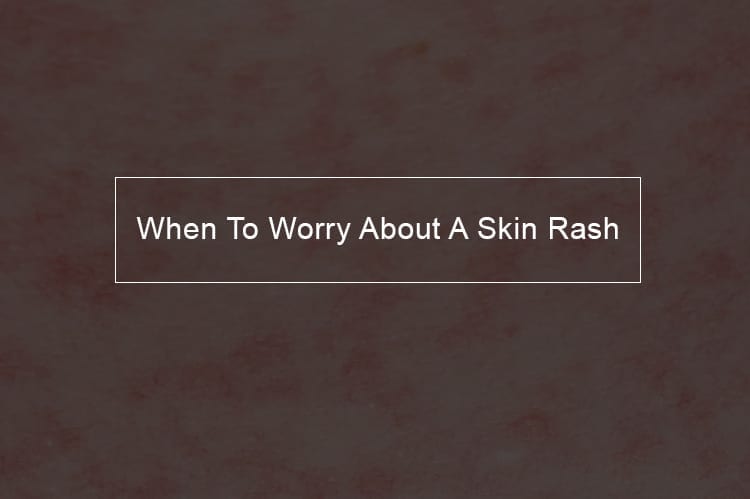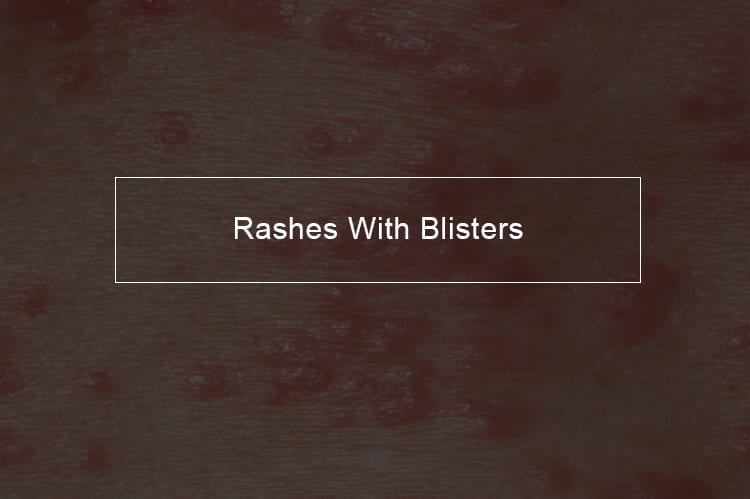
To know if a rash is a serious look for the following signs and symptoms- a rash that covers all over your body, you have a fever with a rash, the rash is sudden and spreads rapidly, if the rash starts to blister, is painful or gets infected.
Rashes are common skin complications with different causes. Most outbreaks are not dangerous but are instead a mere nuisance. Life-threatening skin rashes are rare, but whenever they do happen, you ought to seek immediate medical assistance. If you’re generally feeling unwell and having a rash, that would be a reason to seek medical attention. Your dermatologist or care physician should be able to assist you.
A rash may be a warning sign of a severe medical problem, such as an autoimmune disease or a Lyme infection, explained Dr. Laura Ferris, an associate professor of dermatology at the University of Pittsburgh Medical Center. Or it could merely be due to a harmless, though vexing, insect bite or a brush past some poison ivy.
How Will I know If My Rash Requires Medical Attention?
Signs You need to See a Doctor About your Rash
These outbreaks can come in many forms and, depending on the cause, take days or even weeks to heal. Rather than treating the rash by yourself, see a board-certified dermatologist for the proper diagnosis and treatment. Signs that your rash requires observation by either a doctor or a dermatologist:
If you suffer from a fever or pain alongside the rash outbreak
If this is a fact, pay your doctor a visit to your doctor or head to the emergency room. An allergic reaction or an infection could cause it. Examples of rashes as a result of infection include scarlet fever, measles, mononucleosis, and shingles. You ought to have it checked out, that's according to skin specialists. It could be a sign that you have an infection or are experiencing an allergic reaction.
If you have a sudden spreading of bruise-like lesions
It might be a symptom of vasculitis, and you need to get that looked at because your clotting cells might not be working right. It could be as a result of an allergic reaction. Medications allergies are common, and some may be harmful. If breathing becomes difficult, go to the emergency room or call 911.
If your rash continues unabated
Does your rash persist without improvement from over-the-counter medications? According to dermatologists, you might have an infection. Some outbreaks start entirely mild. However, secondary infection forms due to the integrity of the skin surface, which is a barrier against possible pathogens, has been disrupted. Signs of disease are warmth and pain, a bad odor and yellow or green cloudy discharge.
Any widespread rash
A rash that spreads across your entire body could be a sign of something concerning, for example, an infection or an allergic reaction. It can be a sign of a significant allergic response; such as an internal cause a reaction to medication. For instance, if this occurs within two weeks of starting a new drug, the concern would be a reaction to the medication.
Rashes that Turn Into Blisters
Rashes that begin to blister should send you right to the dermatologist’s office unless you're almost sure you’ve come in contact with poison ivy, this recommendation is according to beauty experts.
In case Your Rash Has Different Colors Like Green or Yellow Fluid
If you have an itchy rash then you scratch it, it may become infected. Signs of an infected rash are yellow or green fluid, swelling, crusting, pain and warmth in the area of the rash, or a red streak coming from the outbreak. Purple spots that form on your hands and feet could be a sign of a bacterial infection of your heart. You can look at the skin as a window to the inside of the body.
Circular-shaped rash in a Lyme Disease Prone Area
If you develop a circular-shaped rash and you’re in an area where Lyme disease is endemic, you should get it checked out.
The rash is painful
A physician should quickly evaluate painful rashes.
A rash that Causes Inflammation
Is there any bruising or swelling around it? The outbreak may be preventing proper blood flow.
Rashes in young infants
The form of the outbreak typically narrows the differential diagnosis. The associated symptoms and signs assist in identifying patients with a severe disorder and often suggest the diagnosis.For a lot of children, the physical examination and history are sufficient for diagnosis. Testing is for possible life threats; it includes renal function tests, Gram stain, and cultures of blood and stool tests for the hemolytic uremic syndrome; CBC, and CSF for meningococcemia.
Life-Threatening Skin Rashes Topic Guide
Life-Threatening Skin Rashes
Potentially fatal disorders that have a skin rash as a primary sign include:
- drug rash with systemic symptoms (DRESS) syndrome and eosinophilia
- necrotizing fasciitis
- toxic epidermal necrolysis (TEN), also known as erythema multiforme major (EM) or Stevens-Johnson syndrome (SJS)
- meningococcemia
- toxic shock syndrome (TSS)
- Rocky Mountain spotted fever
- pemphigus vulgaris (PV)
These conditions cause a rash that may cover large regions of the skin surface. Usually, there are a variety of other significant symptoms and signs that accompany the outbreak and assist in distinguishing the cause.If you still don't want to visit your doctor, try taking a picture of your rash. It can be beneficial when you go in to visit a doctor since the rash could have changed by then. It will be an indicator of what it looked like before you started treating it with hydrocortisone or bacitracin. It will aid in getting a sense of the evolution of the rash.”
What If I Have Blisters on My Rashes?

Rashes have blisters on top of them
Blisters that accompany a severe rash usually have the following characteristics: Blisters involve the thin external layer of the skin that covers large regions of the body. It may mean several small blisters about 1 cm across or a few large blisters several centimeters across. Blisters are tense (full of fluid) at first and then could turn loose before splitting open. When they do rupture, the skin underneath is moist and usually painful. The underlying skin surface then dries up and crusts over.Pressing on a tense blister or scratching the skin next to a blister will extend the blister and make it larger. It is a standard characteristic of these skin conditions.Blisters can include any or all of the mucous membranes just above. Vesicles in these parts may not be conspicuous because they rupture easily, especially in the mouth. Blisters on the mucous membranes that break may be very painful. When they develop in the mouth, pain makes it difficult to consume any food.
When to Worry About Your Rashes?
Three primary rashes are concerning and relatively common in adults.There are three main rashes that adults suffer from, take a look at them below:
Shingles rash aka Zoster
Shingles: The first, and the least severe rash is shingles, also called Zoster, which is as a result of the chickenpox virus giving an encore performance. Shingles is typically a patch or crop of elevated red bumps with blisters on top. Because it follows a single nerve route, it often burns or is painful, and it also develops on a single side of the body only. It is impractical to have shingles on either side of the body simultaneously. The reason shingles are significant is that it can cause terrible pain, especially in the elderly, but early treatment can significantly minimize this pain.
A Rash As a result of an Allergic Reaction
Allergic reaction: The second disturbing rash in adults is an allergic reaction to either medication or food. Now, allergies are not usually harmful, and rashes from drugs are typically mild, giving you merely a bad itch. But other medicines can occasionally result in a severe allergic reaction known as Stevens-Johnson. A Stevens-Johnson rash occurs over the outside of the body and often blisters. The elephant in the room, however, is the ulcers that can develop in the respiratory tract, beginning with the mouth. So in case you are on medications and start to suffer from mouth ulcers and a generalized rash, call your doctor immediately. The rapid onset of hives, especially if it correlates with mouth or throat swelling should prompt you to seek immediate assistance. If breathing is turning into a problem, look for emergency services such as 911
Urticaria Rash aka Hives Which Is The Most Worrying Kind
Urticaria (hives): The final worrying rash in adults is another allergic condition called urticaria, otherwise known as hives. Urticaria is a rapidly spreading, itchy, red-raised rash that can move around--appearing and disappearing all over the body. Most of the time, urticaria is not severe; it just itches a lot. However, there are instances when this allergic reaction, which is as a result of the sudden release of the chemical histamine, is accompanied by difficulty breathing and even a sudden blood pressure drop. That is what can be deadly among people with a peanut allergy or allergic reactions to bee stings. The rapid commencement of hives, especially if it correlates with the lip or throat swelling and difficulty breathing, should prompt you to seek immediate assistance. Since a sudden release of histamine causes it, taking an antihistamine like Benadryl can lessen the rash and buy you some time while you get help.
Rashes home remedies
Rashes come in many kinds and form for many reasons. Nonetheless, there are some basic measures that can fasten up recovery and ease some of the symptoms:
- Use gentle soap - not fragranced. These soaps are occasionally promoted for sensitive skin, or for baby skin.
- Do not wash with hot water - opt for warm.
- Try to let the rash to breathe. Do not cover with any bandage or Band-Aid.
- Avoid rubbing the rash dry, just dab it.
- In case the rash is dry, for example, in eczema, use unscented moisturizers.
- Avoid using any lotions or cosmetics that may be resulting in the rash - for instance, newly bought products.
- Do not scratch to reduce the risk of infection.
- Cortisone creams and lotions that can be bought over-the-counter(OTC) or online may ease itching.
- Calamine can also relieve some rashes, such as chickenpox, poison ivy, and poison oak.
- In case the rash results in mild pain, ibuprofen or acetaminophen may be useful. However, these are not a permanent solution - they will not get rid of the cause of the rash.
- It is essential to speak with a doctor or health practitioner before taking any medication. Compare brands before buying online products or over-the-counter, to make sure the product is suitable.
In case a rash happens with the following signs and symptoms, it is essential to see a doctor:
- pain in joints
- a sore throat
- tender regions near the rash
- in case you have had a recent insect bite or animal
- red streaks near the rash
- a large collection of pus
Even though most the rashes are not a major cause for concern, anyone experiencing the following signs and symptoms should consult a doctor immediately:
- dizziness
- high fever
- rapidly changing coloration on the surface
- severe pain in the neck or head
- feeling like the throat is blocking or blocking difficulty in breathing
- increasing pain or severe pain
- confusion
- swelling of the face or extremities
- repeated vomiting or diarrhea




